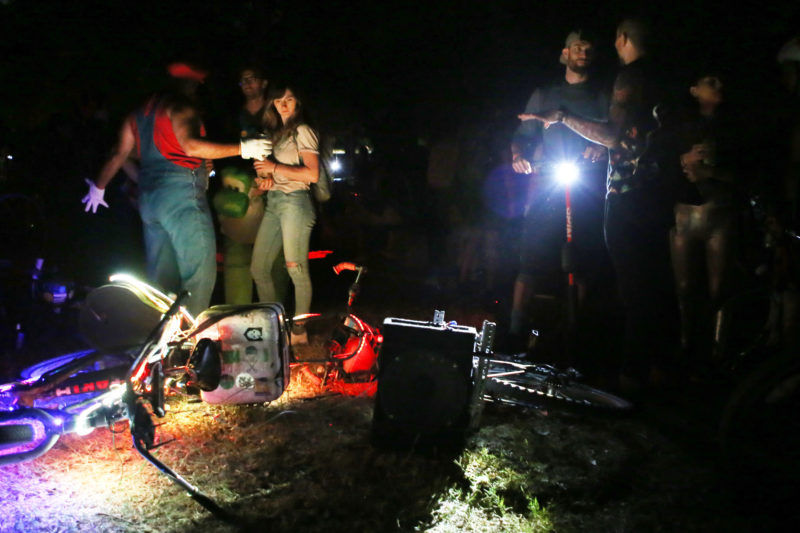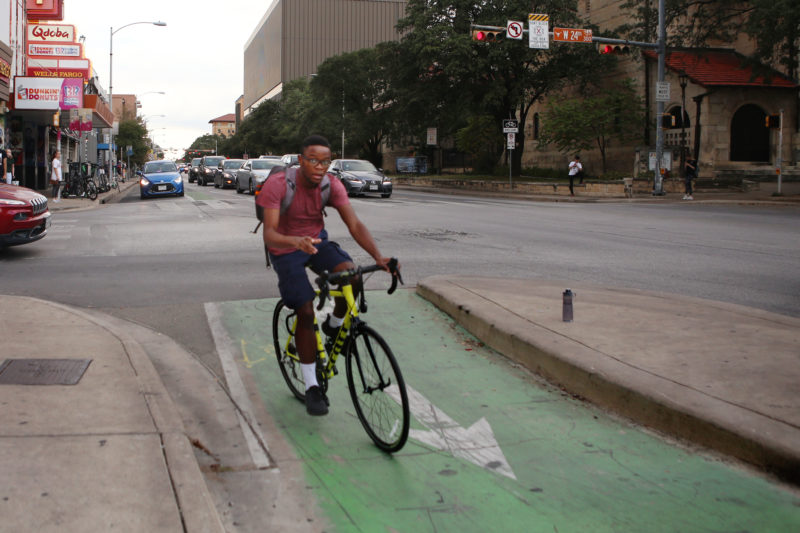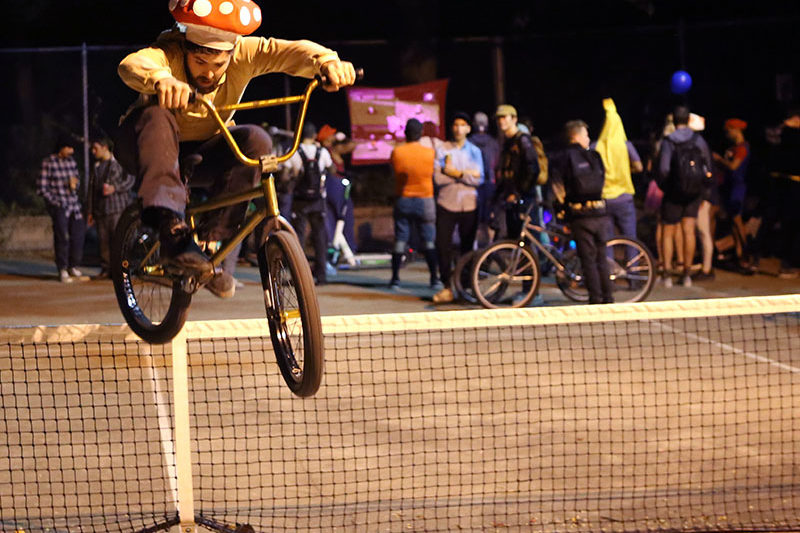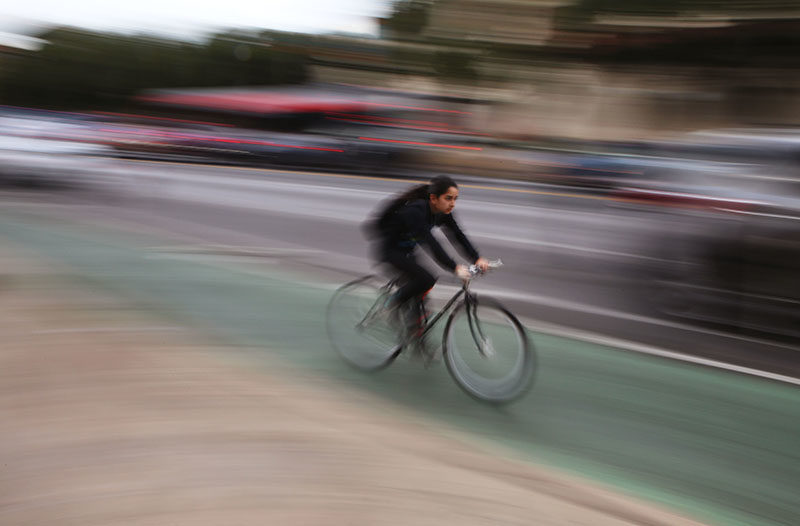The Wheels Keep on Turning: Austinites Divided on Progress of 2014 Bicycle Master Plan
By Aimée Knight
Reporting Texas

Joe Clover, a member of the bicycling club, Social Cycling Austin, demonstrates smoke tricks while spinning his wheel lights before a late-night ride on Oct. 17, 2019. Alexander Thompson/ Reporting Texas
Every Thursday underneath I-35 in downtown Austin, about 150 cyclists convene for a 10-mile ride through the city. The rhythm of cars overhead, trundling down the notoriously congested highway, is almost drowned out by chatter from the cyclists and the music blaring from speakers mounted on their bikes. The ride began in 2009 and highlights the perceived rivalry of the roadway: cars vs bikes. Four wheels vs two. And right now, cars reign supreme.

Members of the Social Cycling Austin bike club gather under the I-35 overpass at East Avenue for the Thursday night social ride. Alexander Thompson/Reporting Texas
“It’s a really empowering thing, to ride on the street and take over a full lane of traffic,” said Isaac Hawkins, 31, a software developer. “It’s about feeling like you belong in a place where you normally don’t — on the roads.”
This struggle — cyclists attempting to stake a claim to riding on streets safely and comfortably — has been a hot issue in Austin for more than a decade and is central to the city’s continued work implementing the 2014 Bicycle Master Plan. Five years after the plan’s adoption, residents are divided on its progress.
The 2014 plan sought to spur a significant expansion of the city’s bicycle network. Taking a page out of the books of bike-centric European cities such as Seville, Spain, the plan championed protected bike lanes: bikeways that are separated from motor vehicle and pedestrian traffic by a physical barrier such as flexible bollards, large bumps and barrier curbs. It set a goal of constructing about 250 miles of bike lanes and paths, of which close to 130 miles would be protected bike lanes.

A cyclist turns into a protected bike lane at the intersection of 24th and Guadalupe Streets on Nov. 5, 2019. To encourage ridership, the city of Austin plans to build more protected lanes like this one which was finished in 2013. Alexander Thompson/Reporting Texas
The plan’s central priority was to build an all-ages and -abilities network of low-traffic neighborhood streets, urban trails and protected bicycle lanes. The network should feel safe enough to ride and intuitive enough to navigate for anyone from the ages of 8 to 80.
Nathan Wilkes, a street designer at the City of Austin who was instrumental in drafting the plan, says the network is 34% complete. According to an interactive online tool released in September, the city hopes to hit its 50% network buildout goal by the end of 2020 and 80% by 2025. The tool does not specify when the city will complete the project.
“I think we’re making really good progress on the plan,” Jim Wick, lead organizer for mobility advocacy group MoveATX, said. “Accelerating the placement of that infrastructure is one of our primary goals, and the city is really making some exciting strides towards that.”
In 2018, Bicycling Magazine ranked Austin 13th on a list of bike-friendly U.S. cities. The ranking assessed cities based on their safety, friendliness, energy and culture. Seattle nabbed the top spot, followed by San Francisco and Fort Collins, Colo. Austin ranked seventh in 2016.
Chris Riley, 55, former Austin City Council member and acting president of advocacy group Bike Austin, doesn’t share Wick’s optimism.
“We haven’t really made any progress on getting protected bike lanes downtown since the completion of the Lance Armstrong Bikeway some years ago on Third Street,” Riley said. “That is not a network.” The bikeway opened in 2010.
Southbound bicyclists on Guadalupe Street between 38th and 45th streets endure maddening conditions, Riley said. “You’re in this tiny little lane 3 feet wide, protected by nothing more than a painted white line on your left,” he said. “You’re sharing that lane with massive 801 buses. It’s outrageous. There’s no reason for that.”
Despite his concerns, Riley said encouraging progress is being made on some streets in the city, including Shoal Creek Boulevard, where a protected bike lane is being built.
In 2013 the city conducted a phone survey to assess residents’ willingness to bike on city streets. Using a framework designed by Portland’s bicycle coordinator, Austinites were sorted into one of four categories: “strong and fearless” (cyclists who ride regardless of roadway conditions), “enthused and confident” (people comfortable sharing the roadway with automotive traffic), “interested but concerned” (those curious about biking but concerned for their safety), and “no way no how” (completely uninterested in cycling).

Cody Cox performs vault tricks over the tennis court net in Eastwoods Park on Oct. 17, 2019. A 2013 phone survey sorted Austin residents’ willingness to ride bikes into categories ranging from “strong and fearless” to “no way, no how.”
The survey found 1-2% of Austin residents fell into the category “strong and fearless,” 15% were “enthused and confident,” 38-45% identified as “interested but concerned” and 39-45% belonged to the “no way, no how” group. The 2014 plan’s goal is to encourage the 38-45% of those interested but concerned residents to adopt bike ridership.
Freelance journalist Jack Craver, 31, is one of the 2% of those “strong and fearless” Austinites. For Craver, bicycle infrastructure is still far from where it should be.
“Biking in Austin is currently something that requires a certain amount of dedication,” Craver said. “Some might say bravery. Some might say masochism.”
On his regular biking route from South Austin to downtown, Craver often opts to ride on the sidewalk for safety along West Oltorf Street, he said.
“I can’t say whether I’ve seen more people biking as a result of improved bike infrastructure, and that’s a testament to the fact that it’s a very gradual process,” Craver said. “It’s very much a patchwork.”
Sophia Benner, the street design project coordinator for the city, said the move from painted to protected bike lanes on parts of the network makes the process more complex. Constructing an on-street protected bike lane requires the collaborative work of multiple departments.

A cyclist rides down the 10-mph bike lane across the University of Texas campus along Guadalupe Street on Nov. 5, 2019. Although this portion of Guadalupe has protected lanes, several traffic posts separating riders from cars, had been knocked over leaving cyclists vulnerable. Alexander Thompson/Reporting Texas
“If, for example, it rains for three weeks straight or if the equipment breaks down, it will completely mess up their plans as street operations, and then it messes up our plans as the designers,” Benner said. “There’s a lot of moving variables.”
Mike Dahmus, 47, a software development manager and avid transportation blogger, views protected lanes as somewhat counterproductive. Riding on bike lane-free streets, or streets with only painted lanes, forces riders to practice signaling and changing lanes with traffic, Dahmus said. “Sooner or later you have to do that if you want to get anywhere.”
More experienced bikers, who might want to get places in a hurry, would find it difficult to overtake slower bikers in a protected lane, Dahmus added.
Despite his opposition to them, Dahmus is positively surprised by how many protected lanes are being built. “I’m seeing a shorter time period between plan and implementation, even if I disagree with some of the implementation choices,” he said.
There is a consensus among cyclists that November 2020 could deliver a generous injection of funds if voters approve a big transit bond package.
“What you could do if you talk about a billion dollars … I mean you could just do amazing things with that,” Craver said. “Things that would all of a sudden get us much closer to that situation where biking doesn’t seem like this big adventure where you’re putting your life at risk.”